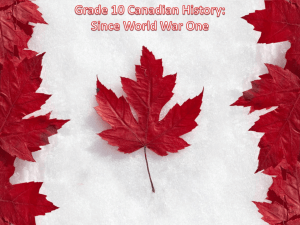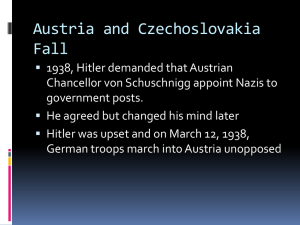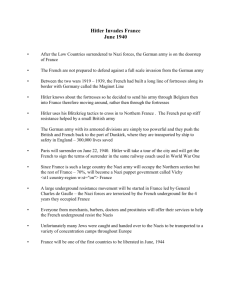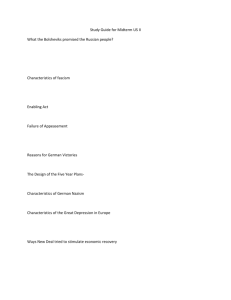HUM 3343: WWII in Europe through History, Literature and Film
advertisement
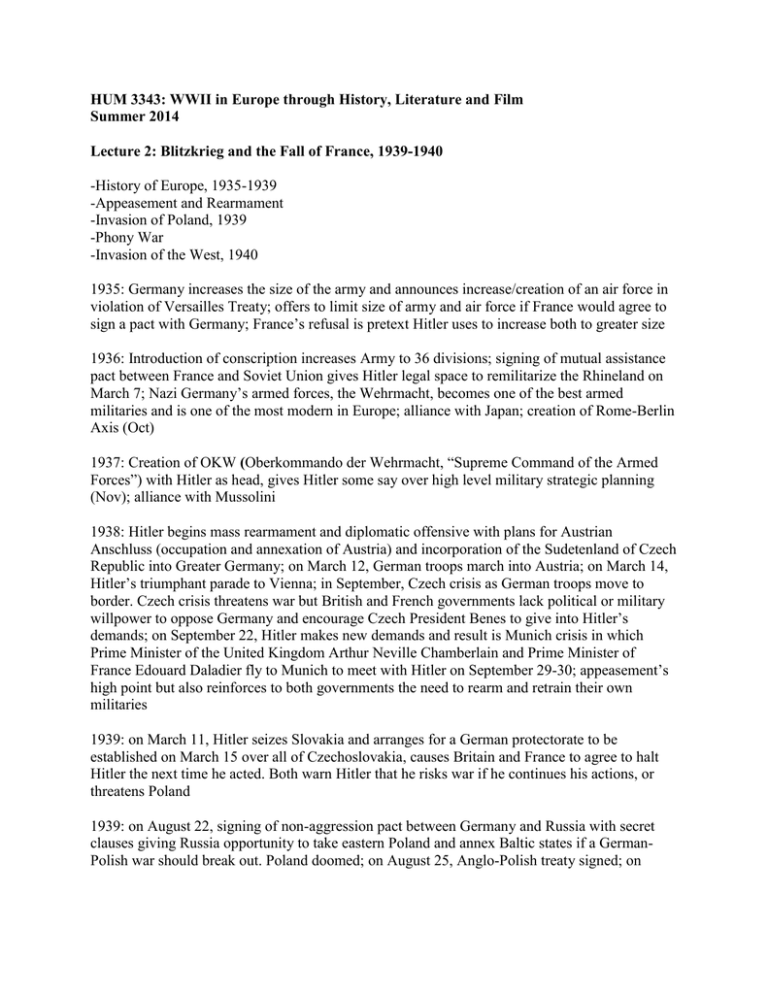
HUM 3343: WWII in Europe through History, Literature and Film Summer 2014 Lecture 2: Blitzkrieg and the Fall of France, 1939-1940 -History of Europe, 1935-1939 -Appeasement and Rearmament -Invasion of Poland, 1939 -Phony War -Invasion of the West, 1940 1935: Germany increases the size of the army and announces increase/creation of an air force in violation of Versailles Treaty; offers to limit size of army and air force if France would agree to sign a pact with Germany; France’s refusal is pretext Hitler uses to increase both to greater size 1936: Introduction of conscription increases Army to 36 divisions; signing of mutual assistance pact between France and Soviet Union gives Hitler legal space to remilitarize the Rhineland on March 7; Nazi Germany’s armed forces, the Wehrmacht, becomes one of the best armed militaries and is one of the most modern in Europe; alliance with Japan; creation of Rome-Berlin Axis (Oct) 1937: Creation of OKW (Oberkommando der Wehrmacht, “Supreme Command of the Armed Forces”) with Hitler as head, gives Hitler some say over high level military strategic planning (Nov); alliance with Mussolini 1938: Hitler begins mass rearmament and diplomatic offensive with plans for Austrian Anschluss (occupation and annexation of Austria) and incorporation of the Sudetenland of Czech Republic into Greater Germany; on March 12, German troops march into Austria; on March 14, Hitler’s triumphant parade to Vienna; in September, Czech crisis as German troops move to border. Czech crisis threatens war but British and French governments lack political or military willpower to oppose Germany and encourage Czech President Benes to give into Hitler’s demands; on September 22, Hitler makes new demands and result is Munich crisis in which Prime Minister of the United Kingdom Arthur Neville Chamberlain and Prime Minister of France Edouard Daladier fly to Munich to meet with Hitler on September 29-30; appeasement’s high point but also reinforces to both governments the need to rearm and retrain their own militaries 1939: on March 11, Hitler seizes Slovakia and arranges for a German protectorate to be established on March 15 over all of Czechoslovakia, causes Britain and France to agree to halt Hitler the next time he acted. Both warn Hitler that he risks war if he continues his actions, or threatens Poland 1939: on August 22, signing of non-aggression pact between Germany and Russia with secret clauses giving Russia opportunity to take eastern Poland and annex Baltic states if a GermanPolish war should break out. Poland doomed; on August 25, Anglo-Polish treaty signed; on August 28, Germans end 1934 non-aggression pact with Poland; on August 31, German radio station attacked, giving Hitler opportunity to invade Poland the next morning (Sept 1) Invasion of Poland: Germans: 62 divisions (6 armored, 10 mech), 1300 modern aircraft Poles: 40 divisions (no armor or mech), 935 aircraft (1/2 obsolete) Pre-dawn raids by Luftwaffe catch most of Polish air force still on the ground, destroying air force; on September 3, Britain and France issue ultimatum for Germany to withdraw; war breaks out between Germany and Britain and France; German 4th Army connects with 3rd Army, cutting off Poland’s outlet to the sea September 7: Poles’ attempt to stand along the Warta River fails and Poles retreat to Warsaw; Germans begin envelopment plan September 17: Warsaw encircled and city is heavily bombed until September 27; Russia crosses border, ending hope of relief September 18: Polish Poznan Army cut off and encircled by German 8th and 10th Armies; nevertheless counterattacks inflict heavy casualties before 100,000 Polish soldiers surrender on the 19th October 6: Polish resistance ends; 910,000 taken prisoners (more than 2000,000 by Russians); 100,000 escape through Lithuania, Hungary, and Romania to France and Britain to eventually form Polish armed forces in exile 1939: Winter War between Russia and Finland begins on November 30 (Russia expelled from League of Nations on December 14); Russians eventually forced to send more than 1 million men against Finland’s 175,000; in January, 40 Finns counterattack but Russians start to bring overwhelming force and by February Russians had broken through Finnish lines; Finland sues for peace on March 12; Finns lose, with casualties at 25,000, Russians more than 200,000 December 13: Scuttling of German pocket battleship Graf Spee in Motevideo Harbour off the coast of Uruguay after being cornered by 3 British cruisers. Hitler humiliated; British people given 1st good news since outbreak of the war Phony War in Western Europe from September 1939 to April 1940 until invasion of Norway in the spring (Churchill referred to period as the “Twilight War,” Germans as “Sitzkrieg,” “sitting war”) 1940: Altmark incident: merchant-supply ship intercepted off Norwegian coast by British destroyer; worried about access to neutral Swedish coal, iron, and water supplies forces Hitler to order OKW to plan for invasion of Norway; also invasion of Denmark as a land bridge to Norway April 9: Germans bombard Copenhagen and land in Norway; threat causes Denmark to surrender; Norwegians fight back, sinking German cruiser while royal family escapes to Britain; Norwegian Army fights in the interior and near Narvik in the far north; Britain and France send assistance April 18-23: Allies land 12,000 troops but are forced to retreat from the south by May 3 April 10-13: Battles at sea around Narvik sink 10 German destroyers and kill much of German General Eduard Dietl’s mountain troops. 2000 mountain infantry and 2600 sailors versus Allied force of 24,500; Nazis try to break out to Swedish border (successfully) at the end of May End of May: Allies recalled home after opening of campaign in France on May 10 June: Nazis recapture all that had lost and Norwegians “surrendered” to homegrown Nazi sympathizer government Invasion of the West 1939: Planning begins in October with creation of Case Yellow (German attack on Low Countries) by OKH (Oberkommando des Heeres, Supreme High Command of the German Army); General von Rundstedt and General von Manstein eventually defect from OKH to support planning by Hitler; after the plan ends up being exposed in January 1940, Hitler orders new invasion plan; result is the Von Manstein plan Battle for France Control rested in the hands of French General Maurice Gamelin, who in turn gives orders to the entire French Army and to the BEF (British Expeditionary Force) under the command of General Lord Gort; part of the RAF in France listen to Gort and part to Bomber Command in London. Gort is too closely identified with his battalion commanders while he is just too old and tired at 68 to be an effective overall commander May 10: German airborne units land near the Hague and Leyden in Holland and on the Meuse River in Belgium; attack on Eben Emael is one of the most daring during the war; Dutch are genuine neutrals—their army had not fought since 1830; on May 13, Queen Wilhelmina of the Netherlands leaves for Britain and the government surrenders on the 14th. Belgians are blamed by the British and French for what eventually comes later: accusations of defeatism and lack of military preparedness German armour strike through the Ardennes while the bulk of British and French forces are fighting in Beligum, mistakenly believing that they are fighting the bulk of the German Army. On May 12th, led by Erwin Rommel, the Germans find the French 2nd Army in retreat and cross the Meuse in bulk on the 13th. The 15th marks the drive forward which the Allies try to stop several times General Weygand (73) is recalled from Syria to take command of the French Army on May 20 but things are out of control by then. Germans attack until the 24th and then are ordered to halt until the 26th so that the infantry can catch up with the faster Panzer Division; on May 23, Britain decides to retreat back to Dunkirk on the coast and by May 26-27, the evacuation of the BEF begins with an improvised flotilla of warships and small boats (Operation Dynamo). 337,000 Allied soldiers (including 110,000 French soldiers) died May 28: Belgian Army surrenders June 5: Hastily arranged Weygand Line breaks and, without any French reserves, the Germans continue to advance June 10: French government moves from Paris to Tours June 17: Marshall Petain takes control of the government June 21: Germans accept an armistice from the French; French government remains in control over southern France and the empire; the Army is to be reduced to 100,000 men and the French government is to pay “occupation costs” to the Germans; new French capital is at Vichy; about 2 million Frenchmen and much of France’s industrial heartland falls into German hands June 25: Armistice takes effect with both Germans and Italians June 16, 1940: Fuehrer Directive No 16 makes direction for a landing operation against the British
